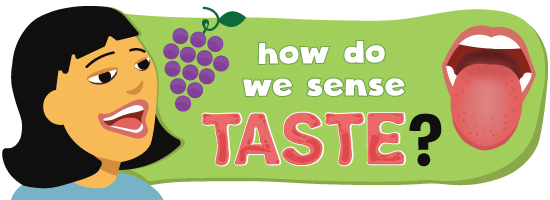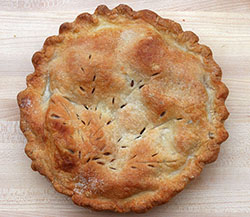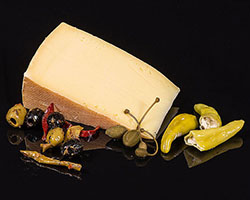
show/hide words to know
Think about the last delicious food that you devoured. Maybe it was a savory, cheesy pizza. Or maybe it was a sweet yet tart slice of apple pie. How did eating it make you feel? What did you like about it? Furthermore, how were you able to taste it? Is there any reason to taste food other than to provide a pleasurable experience?

We get a lot of enjoyment from tasting certain things, like a sweet pie, but why is taste an important sense? Image by Jonathunder.
Beyond the simple enjoyment we get out of eating a tasty meal, a sense of taste is actually crucial to our existence. For early humans, a sense of taste evolved because it helped in identifying whether something was safe to eat or potentially harmful. Before the time of grocery stores and fast food restaurants, getting enough energy to fuel our bodies wasn’t as easy. We needed to find and eat foods that were rich in energy. Taste helps us to do this – energy-rich foods often taste sweet, and produce an enjoyable sensation. On the other hand, poisonous or toxic foods tend to taste bitter, and produce an unpleasant sensation.
The sense of taste, also called gustation, allows us to perceive different flavors from the substances we eat and drink. Just like the other sensory systems, taste relies on the activation of special receptors on the tongue and mouth. A receptor is a structure that collects information from the environment and converts it into a nervous signal that can be understood by the brain. Different kinds of receptors, as part of each sensory system (vison, hearing, touch, smell, taste), allow us to sense things like heat, pain, light, and chemicals.
Every food or drink that you put in your mouth has particular chemical components, and these chemicals are detected by special receptors called chemoreceptors. These chemoreceptors are contained within taste buds on the surface of the tongue. If you look at your tongue, you can see tiny bumps covering the surface, or the epithelium. There are thousands of these bumps, or papillae.
There are three different types of papillae based on their shape – fungiform, foliate, and circumvallate – each type located on a specific area of the tongue. Within each papillae, there are hundreds taste buds and within each taste bud, there are 50-100 chemoreceptor cells.
The Five Tastes
Not all chemoreceptors sense the same kinds of chemicals, or tastes. Humans have five kinds of taste buds – salty, sweet, sour, bitter, and the newly recognized, umami. Each of these types has a specific kind of chemosensitive cell inside. It was originally thought that each type of taste bud (and corresponding taste) was found only on a certain region of the tongue. We now know that this is not the case, and that each taste can be detected throughout the surface of the tongue.
- Sweet taste is overwhelmingly pleasant, and signals the presence of carbohydrates in food. Carbohydrates have a very high calorie content, and are therefore an efficient source of energy.
- Salty taste detects the presence of NaCl, or salt. Salt is a crucial part of the diet – it is used throughout the body in maintaining ion and water homeostasis. Therefore, salt typically produces a pleasant taste.

People often crave salty foods as salt is important to body function. Image by Jonathan M.
- Sour detects the presence of NaCl, but also acids. Sour taste is sometimes pleasant in small amounts, but unpleasant at higher amounts. Sour taste caused by acidic foods can help signal spoiled food, or acid-containing foods that would cause tissue damage if consumed.
- Bitter taste is generally unpleasant. Plants sometimes produce toxins to avoid being eaten, and a bitter taste allows us to identify these. Things like caffeine and nicotine are bitter, but an aversion to such bitter foods can and often is overcome by other pleasant effects these compounds can produce in our bodies.
- Umami taste was first described by a Japanese scientist a little over a century ago and is now generally recognized as the fifth taste. Translated in English, umami means “savor.” Things like cheese, meat, and soy sauce produce this generally pleasant taste. It signals the presence of amino acids and proteins in the food. Proteins have critical roles in the body, including the building of muscle, and the formation of enzymes that catalyze reactions in the body.

Cheese and other savory items have a taste called umami. Image by Hubertl.
Additional images via Wikimedia Commons. Baby face image by Avsar Aras.
View Citation

Humans and other animals use taste as an important tool to learn about their surroundings.
Learn more about our five senses.
Be Part of
Ask A Biologist
By volunteering, or simply sending us feedback on the site. Scientists, teachers, writers, illustrators, and translators are all important to the program. If you are interested in helping with the website we have a Volunteers page to get the process started.







